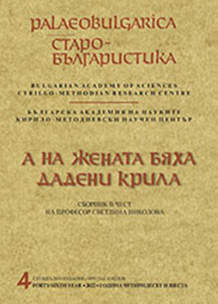Иконографията на св. Наум Охридски и нейното многообразие (Бележки върху три малко известни икони с образа на св. Наум Охридски от Музея за християнско изкуство в София)
The Iconography of St Naum of Ohrid and Its Diversity (Notes on the Three Less Known Icons of St Naum of Ohrid from the Museum of Christian Art in Sofia)
Author(s): Ralitsa RoussevaSubject(s): Fine Arts / Performing Arts, Visual Arts
Published by: Кирило-Методиевски научен център при Българска академия на науките
Keywords: St Naum of Ohrid; iconography; icons; post-byzantine art; Church art.
Summary/Abstract: The first icon is “St Naum with scenes of his life and St Paraskeva” (National Art Gallery № 520; wood/tempera; 34,5 x 27 cm) and depicts: “The Baptising of the Tzar’s Daughter”, “Horse Thief Who Was Caught at the Gates of the Monastery”, “The Miracle of Harnessing the Bear” and “The Dormition of St Naum”. The final scene has a row of six figures with no halos, standing behind the saint’s body and performing the burial ritual. The typological characteristics of those figures features no particular specifics, although their number speaks to the fact that they are, without a doubt, intended to be the remaining of the Seven Slavic Saints. The central figure likely is St Methodius or St Clement of Ohrid, presented as an archbishop. None of the four scenes are based on Hristofor Zhefarovich’s engraving and feature different iconography. It is clear that the zograph was familiar with other depictions of the life of St Naum, and, most likely, scenes featuring the Seven Slavic Sains as well. Featuring St Paraskeva alongside St Naum is not unique either, especially in the Korçë region. The origin of the icon is unknown, although, based on the style and iconography, as well as the Greek captions, one can assume that the provenance is Korçë region. The second icon is “The Benevolent Mother of God, St Nicholas and St Naum” (1842 or 1849; 50,5 x 37,5 cm; National Art Gallery № 897). The icon was painted by a highly-skilled artist, whose style is somewhat similar to that of zographs from the Debar school, although there’s a distinct attempt at being more “academic”. The fact that St Nicholas and St Naum are featured in the same icon implies that it probably originated from the Ohrid region. The third icon of St Naum (1871; National Art Gallery № 105; wood/tempera; 61 x 45 cm) is by Socrates Georgiou – a zograph from Sozopol. St Naum is depicted as an archbishop, with white hair and white beard. This iconography is in line with neither historical data, nor traditional depictions and is instead based on a lithograph of the Seven Slavic Saints, which was printed in the typography of A. V. Morozov in Moscow in 1869. Proof of this are the identical „Sv. Naum Chudotvorets Ohradskii“ caption and well as the matching iconography of certain details. The icon from Sozopol shows that during that late period, the cult towards St Naum was no longer regional, but generally accepted in Orthodox Christianity and had begun spreading in regions further away from Ohrid. The last work presented here is a drawing from a notebook (first half of 19th century; National Art Gallery № 834; pencil on paper) possession of zographs from Elena. St Naum is presented holding a bear tied on a robe, a certain iconography has no parallel.
Journal: PALAEOBULGARICA / СТАРОБЪЛГАРИСТИКА
- Issue Year: 2022
- Issue No: 4 Special
- Page Range: 927-948
- Page Count: 22
- Language: Bulgarian
- Content File-PDF

